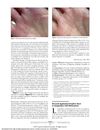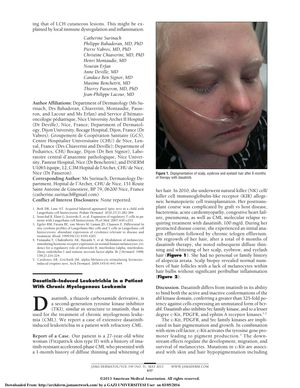TLDR A woman's hair turned white after taking a cancer drug called dasatinib.
The document described a case where a 27-year-old woman with chronic myelogenous leukemia (CML) developed leukotrichia, or hair whitening, after being treated with dasatinib, a tyrosine kinase inhibitor (TKI). The patient, who was resistant to imatinib, experienced hair color changes after 6 months of dasatinib therapy, following an initial anagen effluvium and a subsequent chronic telogen effluvium. A scalp biopsy revealed a normal count of hair follicles but an absence of melanocytes in the hair bulbs. The paper discussed dasatinib's unique mechanism of action, which includes inhibition of kinases involved in hair pigmentation and growth, and suggested that the use of TKIs in cancer treatment may provide further understanding of their effects on skin and hair.
508 citations
,
June 2009 in “Current drug metabolism” Tyrosine kinase inhibitors effectively treat cancers but often cause skin and other side effects.
 136 citations
,
June 2006 in “Journal of Dermatological Science”
136 citations
,
June 2006 in “Journal of Dermatological Science” PDGF isoforms can promote and sustain hair growth.
 192 citations
,
January 2015 in “Journal of the American Academy of Dermatology”
192 citations
,
January 2015 in “Journal of the American Academy of Dermatology” Targeted cancer therapies often cause serious skin problems that need careful management.
 9 citations
,
May 2013 in “JAMA Dermatology”
9 citations
,
May 2013 in “JAMA Dermatology” Sunlight exposure improved a patient's skin condition, and there may be a link between a certain disease and skin growths; a leukemia treatment caused changes in hair color and growth.
 1 citations
,
March 2019 in “Actas Dermo-Sifiliográficas”
1 citations
,
March 2019 in “Actas Dermo-Sifiliográficas” New cancer treatments are less harmful to hair but can still cause hair loss, color, shape, and growth changes.
 25 citations
,
November 2013 in “Journal of the American Academy of Dermatology”
25 citations
,
November 2013 in “Journal of the American Academy of Dermatology” Many patients on new leukemia drugs had mild to moderate skin reactions.
508 citations
,
June 2009 in “Current drug metabolism” Tyrosine kinase inhibitors effectively treat cancers but often cause skin and other side effects.





